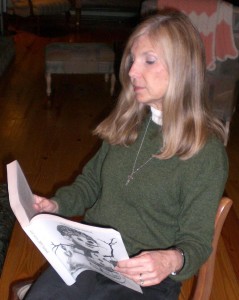We joined the Seed Savers Exchange back in the fall, knowing it was one of the many ways we could begin to learn about the challenges we face as beginners in this whole subsistence farming “thing.” The other day we got the big 2009 Yearbook. What fun!
Many farmers, and nearly all small farmers like us, are worried that the agribusiness giant Monsanto is slowly taking over the production and sale of all seed in the U.S. There’s certainly reason for concern when you read a report like Monsanto vs. U.S. Farmers from the Center for Food Safety. Monsanto has a three-pronged strategy to increase its market clout and control over agricultural seed: (a) heavy-handed “investigations” of farmers it suspects of growing any seed it has ever patented, whether intentional or not, whether as the result of mistake or just wind drift; (b) intense pressure on farmers to reach out of court settlement with Monsanto to avoid an avalanche of David-vs.-Goliath legal expenses; and (c) fight-to-the-finish lawsuits against farmers who refuse to toe the line. To farmers, Monsanto is one scary beast.
 So it was a hearty and bracing antidote to sit down this morning with the Yearbook and see the way farmers in the U.S. and other countries are saving and exchanging seed.The Yearbook is the size of a good-sized phone book and perhaps the last of its kind. In future years, the Yearbook will be solely online to save on printing and postage as well as to make the information more searchable. So we want to enjoy it while we can. We want to delight, for example, in knowing that there are nine farmers right here in Alabama who make seeds of one kind or another available to their fellow farmers. Or how about the sheer joy or reading through more than 12 pages of densely packed listings offering various varieties of garlic?
So it was a hearty and bracing antidote to sit down this morning with the Yearbook and see the way farmers in the U.S. and other countries are saving and exchanging seed.The Yearbook is the size of a good-sized phone book and perhaps the last of its kind. In future years, the Yearbook will be solely online to save on printing and postage as well as to make the information more searchable. So we want to enjoy it while we can. We want to delight, for example, in knowing that there are nine farmers right here in Alabama who make seeds of one kind or another available to their fellow farmers. Or how about the sheer joy or reading through more than 12 pages of densely packed listings offering various varieties of garlic?
690 Listed Members have agreed to make one or more varieties of seed available to others, and together they offer more than 13,000 unique varieties. And being a Listed Member has its compensations. It means, for example, that you get first dibs on seeds that are available in limited quantity. We’re not yet in that privileged group, seeing as how we have yet to grow any food successfully, but we hope to count ourselves as Listed Members soon. What conscientious farmers wouldn’t, when being a Listed Member makes you part of the largest, feistiest, and most successful organization working to keep American agriculture free?
When you’re into subsistence farming, you feel lonely and vulnerable, and you feel yourself constantly at odds with the rest of the planet, so you cling to hope wherever you can find it. We’ve enjoyed hearing Joel Salatin hold court on the resilience that comes from diversified grass farming. We’ve warmed to the gentle wisdom of Wendell Berry on the connections between seemingly unrelated practices and their (eminently foreseeable) results. And yes, we’ve cackled as we read Barbara Kingsolver explore the tentative flirtations of a turkey’s first foray into sex. But I must say, nothing has given us as much hope for the future of resilient and decentralized farming as reading the Seed Savers Yearbook.